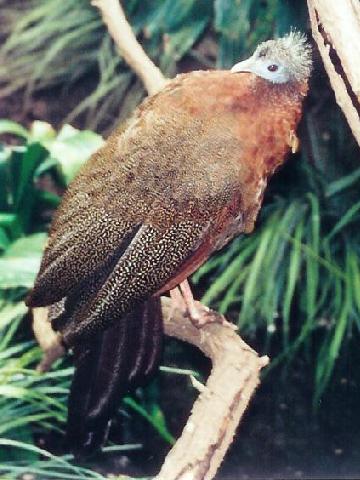- Great Argus
Taxobox
name = Great Argus
status = NT | status_system = IUCN3.1

image_width = 225px
regnum =Animal ia
phylum = Chordata
classis = Aves
ordo =Galliformes
familia =Phasianidae
genus = "Argusianus "
species = "A. argus"
binomial = "Argusianus argus"
binomial_authority = Linnaeus, 1766The Great Argus, "Argusianus argus" (also know as "Phoenix" in some Asia area) is a brown-plumage d pheasant with a small blue head and neck, rufous red upper breast, black hair-like feathers on crown and nape, and red legs. The male is among the largest of all pheasants, with up to 200cm in length. It has very long tail feathers. The male's most spectacular features are its huge, broad and greatly elongated secondary wing feathers decorated with large ocelli. The female is smaller and duller than male, with shorter tails and less ocelli. Young males attain adult plumage in their third year.The Great Argus is distributed in the jungles of
Borneo ,Sumatra andMalay Peninsula insoutheast Asia . It feeds on forest floor in early morning and evening. Unusual amongGalliformes , the Great Argus has no oilgland and the hen lays only two eggs.Though the Great Argus is not as colorful as other
pheasant s, its display surely ranks among the most remarkable. The male clears an open spot in the forest and prepares a dancing ground. He announces himself with loud calls to attract females, then he dances before her with his wings spread into two enormous fans, revealing hundred of "eyes" while his real eyes are hidden behind it, staring at her.Despite displays similar to polygamous birds and though the Great Argus is thought to be polygamous in the wild, it is actually monogamous [http://www.whozoo.org/Intro2002/MarquitaHaf/MYH_arguspheasant.htm] .
The scientific name of the Great Argus was given by
Carolus Linnaeus in reference to the many eyes-likepattern on its wings.Argus is a hundred eyes giant inGreek mythology .Due to ongoing habitat loss and hunted in some areas, the Great Argus is evaluated as Near Threatened on the
IUCN Red List . It is listed on Appendix II ofCITES .References
* Database entry includes a brief justification of why this species is near threatened
External links
* ARKive - [http://www.arkive.org/species/GES/birds/Argusianus_argus/ images and movies of the Great Argus "(Argusianus argus)"]
* [http://www.birdlife.org/datazone/search/species_search.html?action=SpcHTMDetails.asp&sid=283&m=0 BirdLife Species Factsheet]
* [http://www.redlist.org/search/details.php?species=40166 IUCN Red List]
* [http://www.rdb.or.id/detailbird.php?id=350 Red Data Book]
Wikimedia Foundation. 2010.
